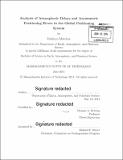Analysis of atmospheric delays and asymmetric positioning errors in the global positioning system
Author(s)
Materna, Kathryn
DownloadFull printable version (5.316Mb)
Other Contributors
Massachusetts Institute of Technology. Department of Earth, Atmospheric, and Planetary Sciences.
Advisor
Thomas A. Herring.
Terms of use
Metadata
Show full item recordAbstract
Abstract Errors in modeling atmospheric delays are one of the limiting factors in the accuracy of GPS position determination. In regions with uneven topography, atmospheric delay phenomena can be especially complicated. Current delay models used in analyzing GPS data from the Plate Boundary Observatory (PBO) are successful in achieving millimeter-level accuracy at most locations; however, at a subset of stations, the time series for position estimates contain an unusually large number of outliers. In many cases these outliers are oriented in the same direction. The stations which exhibit asymmetric outliers occur in various places across the PBO network, but they are especially numerous in California's Mammoth Lakes region, which served as a case study for this project. The phenomenon of skewed residuals was analyzed by removing secular trends and variations with periods longer than 75 days from the signal using a median filter. The skewness of the station position residuals was subsequently calculated in the north, east and up directions. In the cases examined, typical position outliers are 5-15 mm. In extreme cases, skewed position residuals, not related to snow on antennas, can be as large as 20 mm. I examined the causes of the skewness through site-by-site comparisons with topographic data and various forms of weather data such as numerical weather models, radiosondes, and satellite images. Analysis suggests that the direction of the skewness is generally parallel to the local topographic gradient at a scale of several kilometers. Comparison with weather data suggests that outlier data points in the Mammoth Lakes region occur when lee waves are likely to form downstream of the Sierra Nevada Mountains. The results imply that coupling between the atmosphere and local topography, e.g. lee waves, is responsible for the phenomenon of skewed residuals.
Description
Thesis: S.B., Massachusetts Institute of Technology, Department of Earth, Atmospheric, and Planetary Sciences, 2014. 15 Cataloged from PDF version of thesis. Includes bibliographical references (pages 50-51).
Date issued
2014Department
Massachusetts Institute of Technology. Department of Earth, Atmospheric, and Planetary SciencesPublisher
Massachusetts Institute of Technology
Keywords
Earth, Atmospheric, and Planetary Sciences.